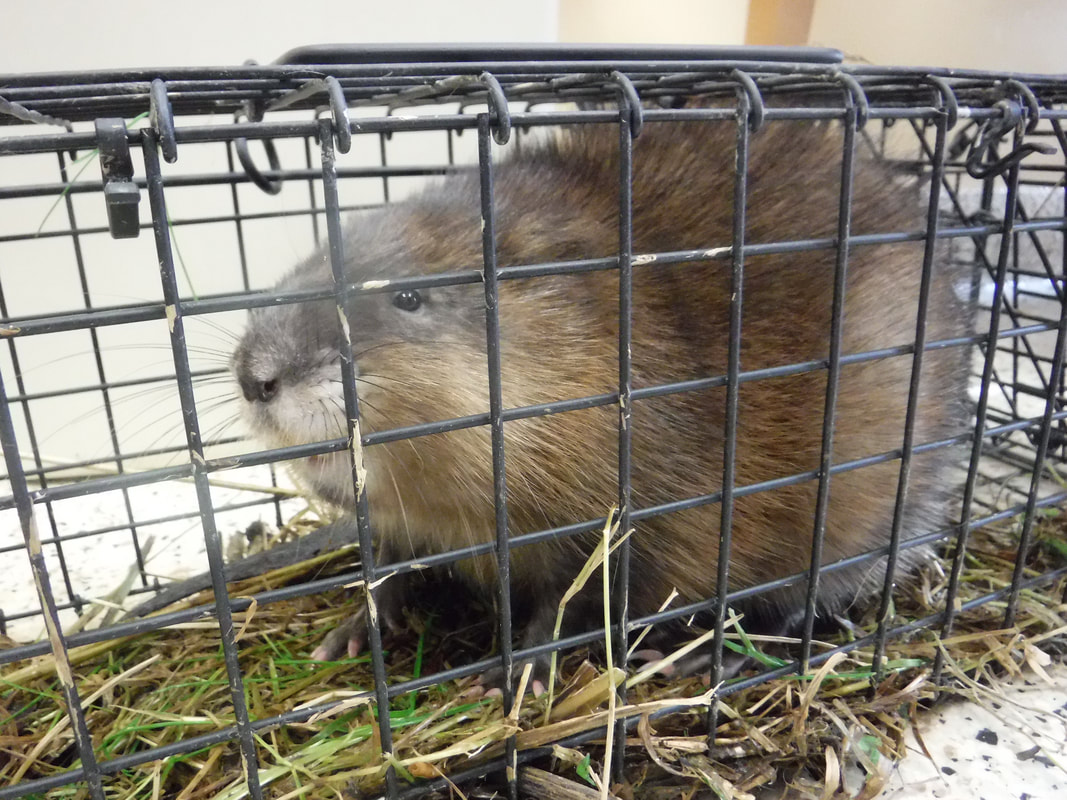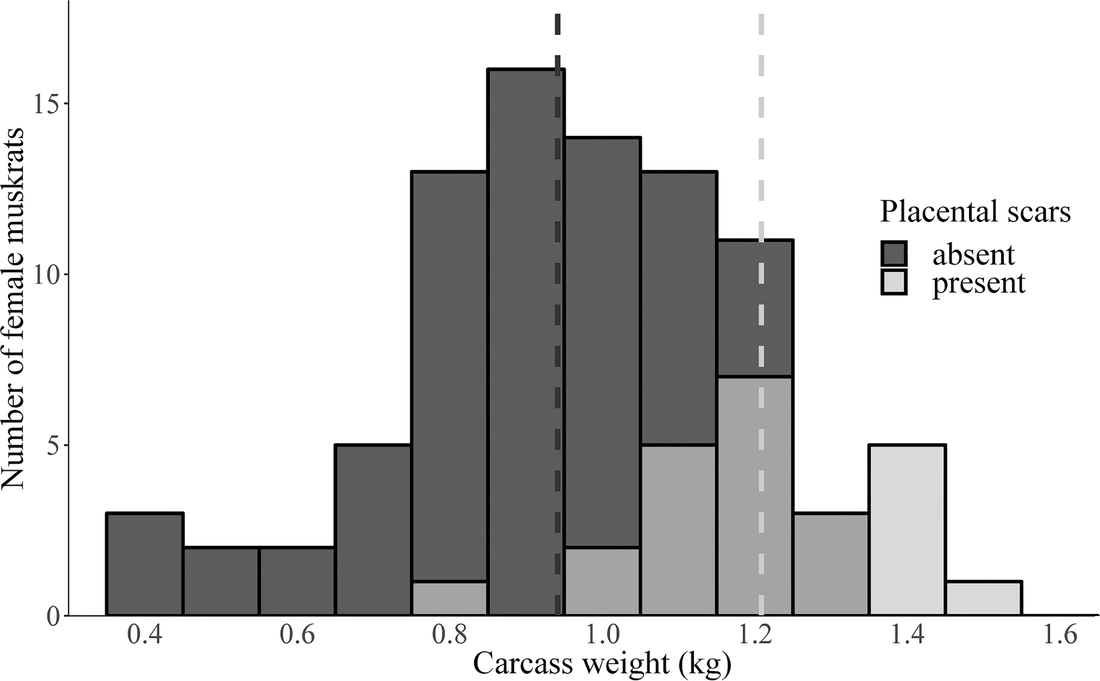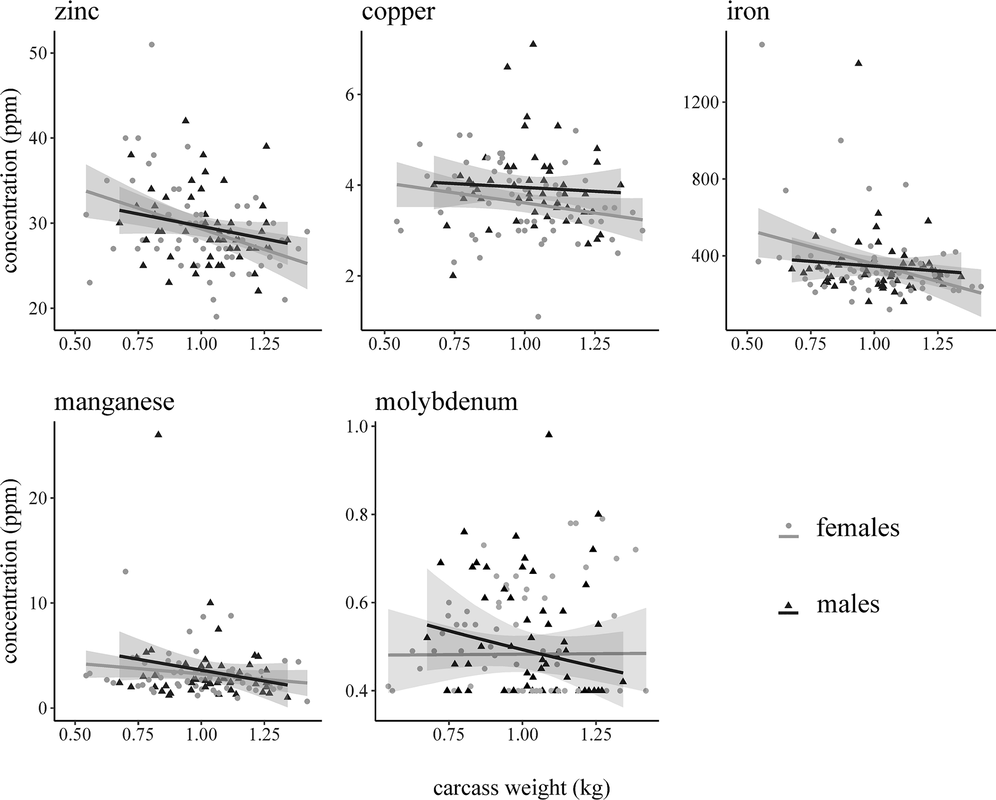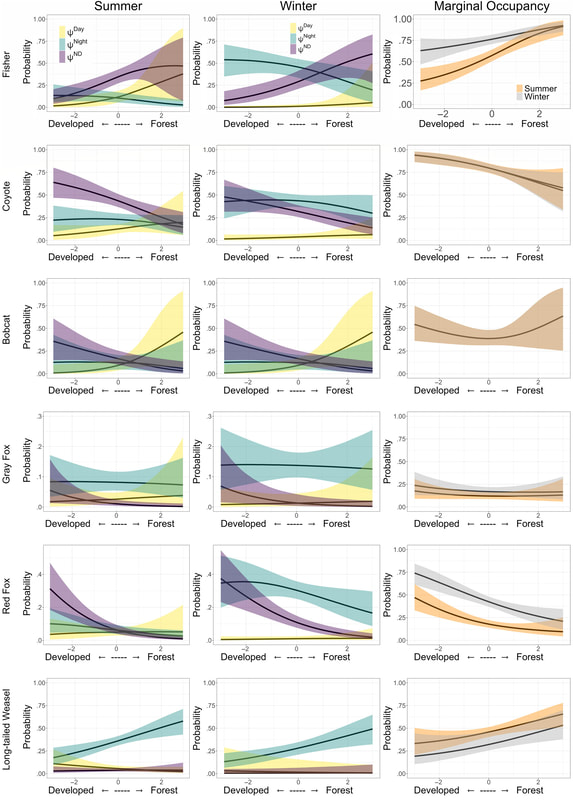Publications
A review of pathogens, diseases, and contaminants of muskrats (2020)
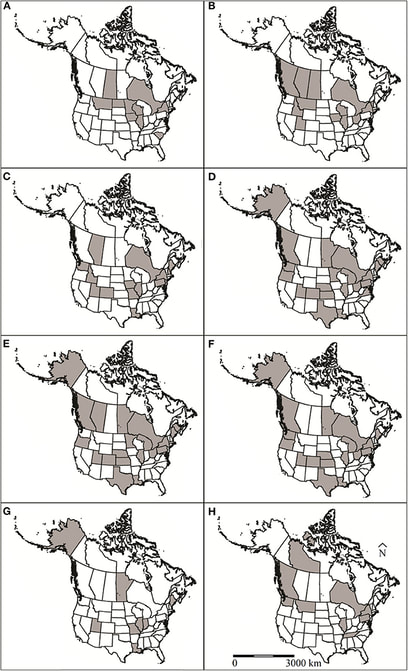
Figure 1. U.S. states and Canadian provinces that muskrat (Ondatra zibethicus) health surveys have been conducted in North America for (A) viruses, (B) bacteria, (C) protozoan parasites, (D) trematodes, (E) cestodes, (F) nematodes, (G) ectoparasites, and (H) toxins and contaminants. Locations designated by shaded regions.
|
Abstract: Over the last 50 years, significant muskrat (Ondatra zibethicus) harvest declines have been observed throughout North America. Several theories for the decline have been proposed, including increased parasite infections and disease within muskrat populations. No existing wholistic review of muskrat exposure to pathogens, contaminants, and diseases exists. To address this knowledge gap, we conducted a thorough review of existing literature on muskrat pathogens, contaminants, and diseases across their natural range. This review is comprised of 131 articles from 1915 to 2019 and from 27 U.S. states and 9 Canadian provinces. A wide diversity of contaminants, toxins, and pathogens were reported in muskrats, with the most common diseases being cysticercosis, tularemia, Tyzzer's disease, and biotoxin poisoning from cyanobacteria. This review provides a summary of muskrat pathogens, contaminants, and diseases over a century that has observed significant population declines throughout the species' range in North America. Such data provide a baseline for understanding the potential role of disease in these declines. In addition, these data highlight critical knowledge gaps that warrant future research efforts.
Citation: Ganoe, L.S., J.D. Brown, M.J. Lovallo, M.J. Yabsley, M.G. Ruder, W.D. Walter. 2020. A review of pathogens, diseases, and contaminants of muskrats (Ondatra zibethicus) in North America. Frontiers in Veterinary Science, 7:233. doi:10.3389/fvets.2020.00233 |
Ecology of an isolated muskrat population during regional population decline (2021)
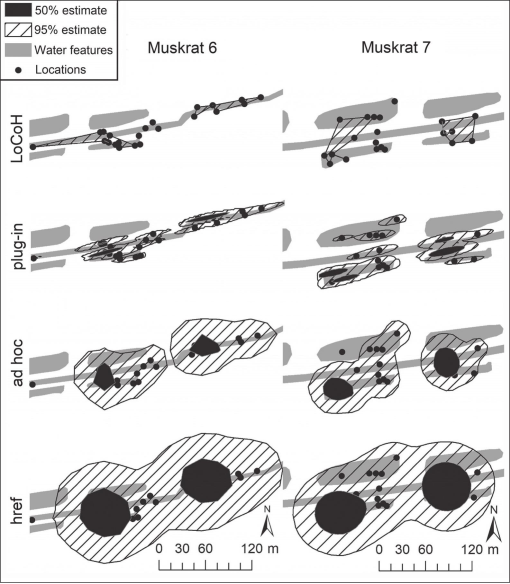
Fig 2. Comparison of all 4 (kernel density estimator [KDE]href, KDEad hoc, KDEplug-in, and local convex hull [LoCoH]) estimators of home range for the 95% and 50% isopleths for 2 individual Ondatra zibethicus (Muskrat) from August 2018 to February 2019. The pond–stream matrix in Lewisburg, PA, is depicted by the gray-shaded areas and labeled as water features.
|
Abstract: Evidence indicating a decline in Ondatra zibethicus (Muskrat) populations in the United States during the past 40 years has led to speculation regarding factors influencing Muskrat survival. In order to understand population dynamics and survival, it is important to first define the ecology of local populations. We investigated the dwelling structure use, movements, home range, and survival of radio-tagged Muskrats (n = 14) in an urban wetland complex in central Pennsylvania. We used locations collected from intensive radio-telemetry monitoring to determine number of lodging structures used, hourly movement, and size and percent area overlap of home ranges. Muskrats shared an average of 9 lodging structures, and on average, 68% of a Muskrat's home range overlapped home ranges of other Muskrats. We used 4 home-range estimators (kernel density estimator [KDE]href, KDEad hoc, KDEplug-in, and local convex hull estimator) to assess the ability of each estimator to represent Muskrat home ranges. The KDEplug-in that constrained the estimate of home range to habitat boundaries provided the most appropriate home-range size for Muskrats in a linear–non-linear habitat matrix. We also calculated overwinter survival estimates using known-fate models. Our top model indicated a positive effect of the average weekly precipitation on survival, with an overwinter survival estimate of 0.59 (SE = 0.16). The main cause of Muskrat mortality was predation by Neovison vison (American Mink; n = 6). The small sample size and uncertainty surrounding our model selection led to weak estimates of survival; however, our model suggests that snowfall may be an important factor in Muskrat survival. Our study provides novel data on Muskrat ecology in Pennsylvania as well as preliminary evidence for future investigations of factors affecting Muskrat survival during the winter months.
Citation: Ganoe, L.S., M.J. Lovallo, J.D. Brown, D.R. Diefenbach, W.D. Walter. 2021. Ecology of an isolated muskrat (Ondatra zibethicus) population during regional population decline. Northeastern Naturalist, 28(1): 49-64. https://doi.org/10.1656/045.028.0104 |
Surveillance for diseases, pathogens, and toxicants of muskrat in Pennsylvania (2021)
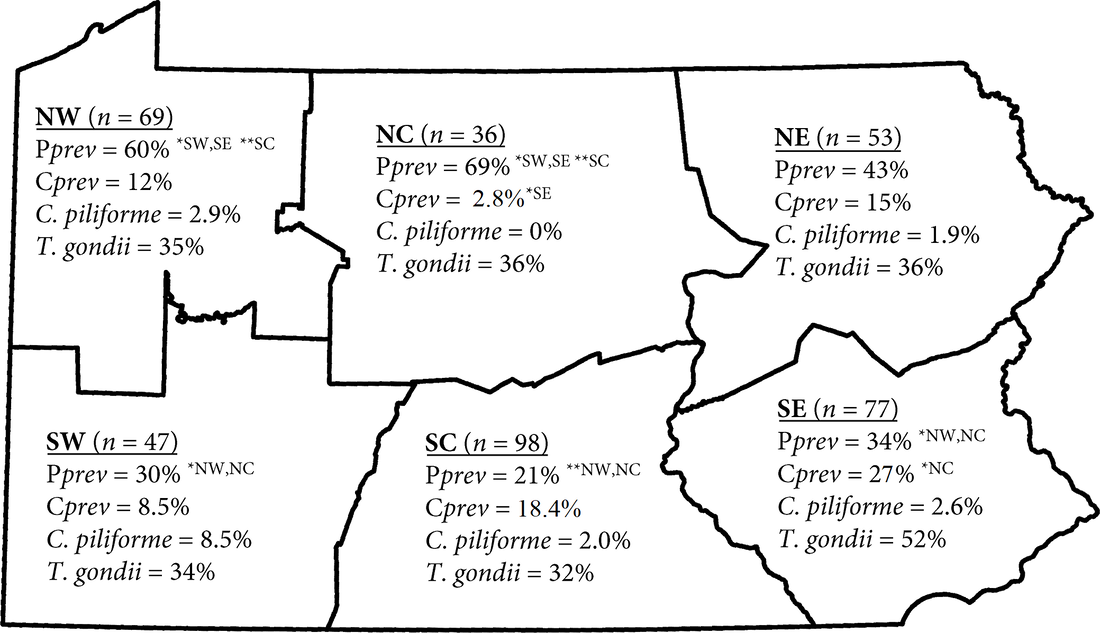
Fig 6. Prevalence of intestinal helminths (Pprev), cysts (Cprev), Clostridium piliforme, and Toxoplasma gondii in muskrats (Ondatra zibethicus) by region (NW-Northwest, SW-Southwest, NC-Northcentral, SC-Southcentral, NE-Northeast, SE-Southeast) in Pennsylvania, USA, 2018–2019.
* = P < 0.001, ** = 0.001 < P < 0.05.
|
Abstract: Using diagnostic data and contemporary sampling efforts, we conducted surveillance for a diversity of pathogens, toxicants, and diseases of muskrats (Ondatra zibethicus). Between 1977 and 2019, 26 diagnostic cases were examined from Kansas and throughout the Southeast and Mid-Atlantic, USA. We identified multiple causes of mortality in muskrats, but trauma (8/26), Tyzzer’s disease (5/6), and cysticercosis (5/26) were the most common. We also conducted necropsies, during November 2018—January 2019 Pennsylvania muskrat trapping season, on 380 trapper-harvested muskrat carcasses after the pelt was removed. Tissue samples and exudate were tested for presence of or exposure to a suite of pathogens and contaminants. Gastrointestinal tracts were examined for helminths. Intestinal helminths were present in 39.2% of necropsied muskrats, with Hymenolepis spp. (62%) and echinostome spp. (44%) being the most common Molecular testing identified a low prevalence of infection with Clostridium piliforme in the feces and Sarcocystis spp. in the heart. We detected a low seroprevalence to Toxoplasma gondii (1/380). No muskrats were positive for Francisella tularensis or Babesia spp. Cysticercosis was detected in 20% (5/26) of diagnostic cases and 15% (57/380) of our trapper-harvested muskrats. Toxic concentrations of arsenic, cadmium, lead, or mercury were not detected in tested liver samples. Copper, molybdenum, and zinc concentrations were detected at acceptable levels comparative to previous studies. Parasite intensity and abundance were typical of historic reports; however, younger muskrats had higher intensity of infection than older muskrats which is contradictory to what has been previously reported. A diversity of pathogens and contaminants have been reported from muskrats, but the associated disease impacts are poorly understood. Our data are consistent with historic reports and highlight the wide range of parasites, pathogens and contaminants harbored by muskrats in Pennsylvania. The data collected are a critical component in assessing overall muskrat health and serve as a basis for understanding the impacts of disease on recent muskrat population declines.
Citation: Ganoe, L.S., J.D. Brown, M.J. Lovallo, M.J. Yabsley, M.G. Ruder, W.D. Walter. 2021. Surveillance for diseases, pathogens, and toxicants of muskrat (Ondatra zibethicus) in Pennsylvania and surrounding regions. PLoS ONE 16(12): e0260987. https://doi.org/10.1371/journal.pone.0260987 |
Fatal infection with Versteria sp. in a muskrat (2021)
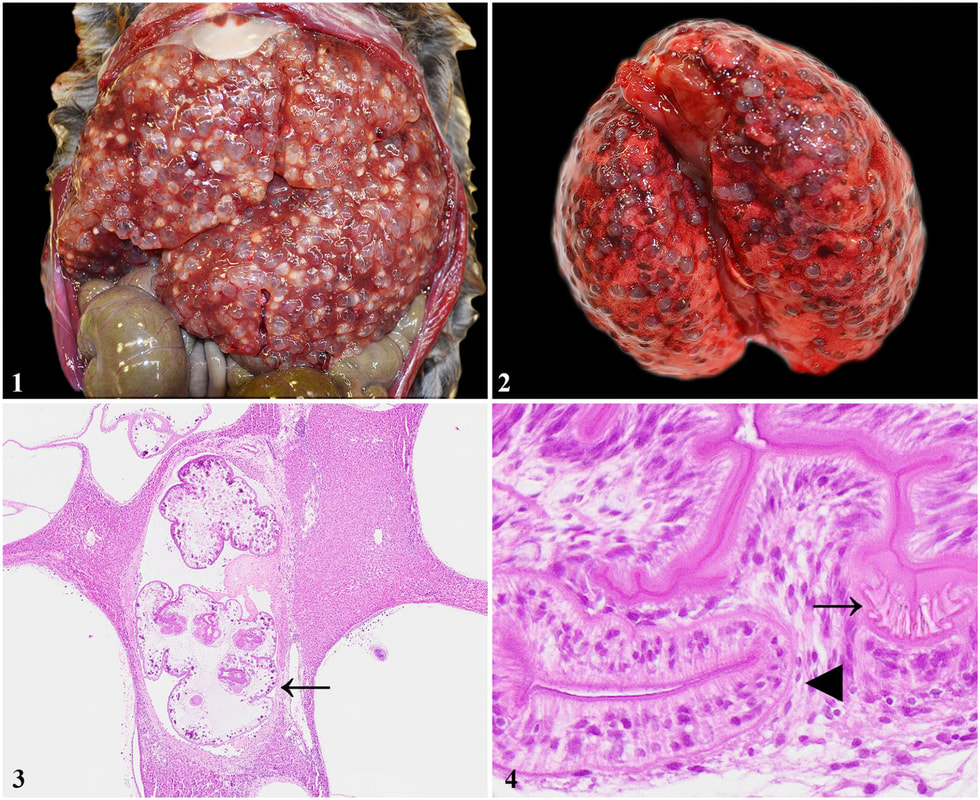
Figures 1–4. Systemic Versteria sp. infection in a muskrat (Ondatra zibethica). Figure 1. Dozens of tapeworm cysts in the liver. Figure 2. Tapeworm cysts throughout the lungs. Figure 3. In the liver, the cysts effaced the parenchyma and contained polycephalic tapeworm larvae covered by a thin capsule/bladder cell (arrow). H&E. Figure 4. In the liver, the rostellum of 1 scolex containing 2 rows of short hooks (arrow) and adjacent sucker (arrowhead) characteristic of Versteria sp. H&E
|
Abstract: The Taeniidae tapeworms are a family of helminths that have a similar life cycle, with intermediate hosts developing characteristic cysts in visceral organs. We describe here a case in Pennsylvania, USA, of fatal Versteria infection in a muskrat (Ondatra zibethicus), which, to our knowledge, has not been reported to develop disease associated with infection. Postmortem examination revealed widespread tissue loss and replacement by solid-bodied cestode larvae with minimal adjacent inflammation in many visceral organs, most severe in the lungs, liver, and brain. Key morphologic features via histology included cephalic structures and short rostellar hooklets, which are characteristic for the genus. Genetic characterization confirmed the cestode as being an undescribed lineage of Versteria that has been implicated as the cause of severe morbidity and mortality in humans and nonhuman primates in North America. Considering the zoonotic significance of this pathogen, our report expands on the limited literature regarding disease caused by Versteria and emphasizes the need to identify the causative tapeworm more accurately, especially in rodent intermediate hosts given that previous reports do not have molecular confirmation of species.
Citation: Niedringhaus, K.D., L.S. Ganoe, M.J. Lovallo, W.D. Walter, M.J. Yabsley, J.D. Brown. Fatal infection with Versteria sp. in a muskrat, with implications for human health. Journal of Veterinary Diagnostic Investigation. December 2021. doi:10.1177/10406387211064270 |
Transient persistence of bobcat occurrence throughout a human‐dominated landscape (2022)
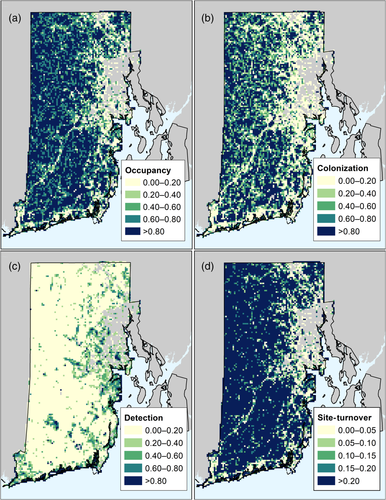
Fig 4: Predictive maps of the (a) probability of occupancy at equilibrium of colonization and extirpation, (b) probability of site-level colonization ( γ ), (c) detection probability for a survey at a site (p), and (d) probability of site-level turnover from one season to the next. The maximum estimated probabilities were 0.87 for occupancy, 1.00 for colonization, 0.91 for detection, and 0.27 for site-turnover [Color figure can be viewed at wileyonlinelibrary.com]
Citation: Mayer A.E., T.J. McGreevy Jr, C. Brown, L.S. Ganoe, B.D. Gerber (2022). Transient persistence of bobcat (Lynx rufus) occurrence throughout a human-dominated landscape. Population Ecology, 1:13. doi:10.1002/1438-390X.12123 10.1002/1438-390X.12123
|
Abstract: Human developments have detrimental effects on wildlife populations globally with carnivores being particularly sensitive. The bobcat (Lynx rufus) is often considered an adaptable mesocarnivore that occurs throughout varied landcover types within its wide distribution and may be less susceptible to the negative effects of development. Our objectives were to investigate the landscape occupancy dynamics of bobcats in a highly developed and densely populated region of the northeastern United States to evaluate the sensitivity of bobcat occurrence to natural and anthropogenic landscape features. We established a large-scale camera trapping survey throughout Rhode Island, USA, sampling from 2018 to 2020. Using dynamic occupancy models, we found initial site occupancy was positively influenced by the amount of forested wetland habitat, while increasing road density and shrub cover negatively influenced the probability of site colonization. Surprisingly, we found no hypothesized variables to influence site-level extirpation probability, or any seasonal effects on dynamic parameters. Lastly, we found that forest cover and road density negatively influenced the probability of detection. The probability of occupancy was high, >0.8, throughout much of the study area (49%), but we also found relatively high site transients, with the probability a site would change occurrence status from season to season at ≈0.27 in the majority of the study area (70%). Our results show that although bobcats can persist in human-dominated landscapes, they require contiguous natural areas to do so. Future expansion of road infrastructure may reduce habitat connectivity and increase road mortalities, thus jeopardizing the population.
|
Diel activity structures the occurrence of a mammal community in a human-dominated landscape (2023)
|
Figure 5: Predicted probability of seasonal and multistate diel occupancy and marginal occupancy (site occurrence, regardless of state; 𝝍2 + 𝝍3 + 𝝍4) for mesocarnivores. The solid black line represents the median and the colored envelopes indicate the 95% credible intervals. For each species, the predicted probability of site occupancy for each occupancy state (Day, Night, or Day/Night) is plotted for varying levels of PCA where positive values indicate more forest cover and negative values indicate more development. The most supported model for bobcat did not include a parameter for season, so no differences are shown between summer and winter.
|
Abstract: Anthropogenic developments alter the environment and resources available to wildlife communities. In response to these real or perceived threats from this development, species may adjust their spatial occurrence. Additionally, wildlife species may adjust when in diel time (24-h light–dark cycle) they occupy sites on the landscape to adapt to changing conditions. However, many wildlife studies only focus on where a species does and does not occur, ignoring how species may shift their diel activity at sites to mitigate threats. We used a multi-state diel occupancy modeling framework to investigate how a community of mammals (mesocarnivores, urban-adapted omnivores, and herbivore/small mammals) respond to differing levels of anthropogenic development and forest cover across two climatic seasons. We collected camera trap data at 240 survey locations across the summer and winter of 2021–2022. We modeled multi-state diel occupancy for 14 mammal species with extent of development/forest and season hypothesized to influence diel occupancy and season hypothesized to influence the probability of detection. We found that all species displayed heterogeneity in both diel occupancy and detection either by extent of development/forest and or season. Within the mesocarnivore species group, coyote and red fox were less sensitive to development and had higher occupancy probability at these sites in general but used them more during the night, while more sensitive mesocarnivores including fisher and bobcat occupied the day state only when there was increasing forest cover. Our results highlight the importance of incorporating diel activity in habitat modeling to better understand the relationship between a species and its landscape, particularly in a region that is vulnerable to increased anthropogenic pressure.
Citation: Mayer AE, LS Ganoe, C Brown, BD Gerber. 2023. Diel activity structures the occurrence of a mammal community in a human dominated landscape. Ecology and Evolution 13(11):e10684. doi: 10.1002/ece3.10684
|
Using global remote camera data of a solitary species complex to evaluate the drivers of group formation (2024)
|
Figure 2. The probability of each member of the Martes complex (martens and close relatives) being detected in groups (two or more individuals) based on generalized linear mixed effects models of a globally derived camera trapping dataset collected between 2000 and 2020.
|
Abstract: The social system of animals involves a complex interplay between physiology, natural history, and the environment. Long relied upon discrete categorizations of “social” and “solitary” inhibit our capacity to understand species and their interactions with the world around them. Here, we use a globally distributed camera trapping dataset to test the drivers of aggregating into groups in a species complex (martens and relatives, family Mustelidae, Order Carnivora) assumed to be obligately solitary. We use a simple quantification, the probability of being detected in a group, that was applied across our globally derived camera trap dataset. Using a series of binomial generalized mixed-effects models applied to a dataset of 16,483 independent detections across 17 countries on four continents we test explicit hypotheses about potential drivers of group formation. We observe a wide range of probabilities of being detected in groups within the solitary model system, with the probability of aggregating in groups varying by more than an order of magnitude. We demonstrate that a species’ context-dependent proclivity toward aggregating in groups is underpinned by a range of resource-related factors, primarily the distribution of resources, with increasing patchiness of resources facilitating group formation, as well as interactions between environmental conditions (resource constancy/winter severity) and physiology (energy storage capabilities). The wide variation in propensities to aggregate with conspecifics observed here highlights how continued failure to recognize complexities in the social behaviors of apparently solitary species limits our understanding not only of the individual species but also the causes and consequences of group formation.
Citation: Twining, JP, et al. 2024. Using global remote camera data of a solitary species complex to evaluate the drivers of group formation. Proceedings of the National Academy of Sciences 121(12) : e2312252121
|
A STATISTICAL POPULATION Reconstruction model for wildlife populations: A case study with white-tailed deer and fisher (2024)
|
Abstract: Harvested wildlife populations should ideally be monitored to inform harvest policies and decision-making to help achieve management objectives. When the age of harvested individuals can be obtained, these data (i.e., age-at-harvest data) can be used to estimate trends of abundances, demographic rates, and harvest probabilities by the statistical reconstruction of the living population. This approach was developed primarily within the frequentist framework and requires the inclusion of auxiliary data (e.g., radiotelemetry data). We developed a novel Bayesian hierarchical approach allowing the population reconstruction from the definition of the species' life cycle without auxiliary data. The hierarchical model assumes that individuals are harvested from an open population whose fluctuations result from demographic processes, and the definition of a superpopulation composed of pseudo-individuals from which the harvested population is drawn. We evaluated the ability of our model to estimate abundances, survival, recruitment, and harvest probabilities based on simulations guided by the demographic processes of a long-lived mammal population. We considered model performance across scenarios, including varying age and temporal structures, superpopulation size, and prior information. We showed how prior information selected based on life history characteristics affects the accuracy of estimated parameters. We found that the model estimates accurate demographic parameters and abundances when the age-at-harvest matrix comprises more than two age classes. Furthermore, an increase in demographic information (number of age groups and years) increased the precision of the estimated parameters. We apply our model to a population of harvested (2012–2021) white-tailed deer (Odocoileus virginianus) and a mammalian carnivore, the fisher (Pekania pennanti), from Rhode Island, USA. Our model estimated biologically realistic population size and demographic rates for both species. Our approach provides robustness to track the population abundance of harvested species through time and estimate fundamental demographic parameters. Such results can be used to monitor whether population objectives are being met and whether harvest policy changes are required. Furthermore, this information can be critical for evaluating the effect of harvest on population growth and projecting trajectories of age-structured populations under different harvest scenarios. Therefore, our framework can help to guide management decisions and species conservation.
Citation: Bellier E, DC Ferreira, DM Kalb, LS Ganoe, AE Mayer, BD Gerber. 2024. A statistical population reconstruction model for wildlife populations: A case study with white-tailed deer and fisher. Ecosphere, 15(6):e4878. doi: 10.1002/ecs2.4878. |
Mesocarnivore sensitivity to natural and anthropogenic disturbance leads to declines in occurrence and concern for species persistence (2024)
|
Figure 5. Maps of predicted mesocarnivore occurrence across the study area in summer and winter for the first and last years of the study (green and blue panels, respectively). Gray panel maps represent the winter and summer predicted stable state occurrence (psi_eq).
|
Abstract: Understanding mesocarnivore responses to both natural and anthropogenic disturbance is crucial for understanding species' potential to maintain landscape persistence into the future. We examined the response of five mesocarnivore species (bobcat, coyote, fisher, gray fox, and red fox) to both types of disturbances and climatic conditions. The Northeastern U.S. has experienced multiple large-scale disturbances, such as a mass defoliation event following larval spongy moth outbreak and high densities of infrastructure that divide the natural landcover into roadless zones where these species inhabit. Using dynamic occupancy models in a Bayesian framework, we aimed to (1) examine variation in species' responses over a 4-year study by estimating variation in site-level occupancy, colonization and extirpation of each species in the state of Rhode Island relative to natural disturbance (i.e., defoliation event), anthropogenic disturbance (i.e., parceling of natural landcover bounded by roads, distance to roads), and climate (i.e., seasonal precipitation) and (2) compare current occurrence trends to predicted asymptotic occupancy to identify key variables contributing to distribution instability. Our findings indicated declines in the occurrence of both fox species, and fisher. There was variation in mesocarnivore response to disturbance among the species. We found gray fox and fisher occupancy dynamics to be sensitive to all forms of disturbance and coyote occurrence was positively associated with anthropogenic disturbance. Although bobcat and red fox were predicted to respond positively to future climate scenarios, fisher and gray fox were not, and persistence of fisher and gray fox in a landscape of disturbance relies on large areas with high forest and shrubland cover. With the wide-spread spongy moth outbreak across much of southern New England, our findings indicate that efforts to conserve forested lands may be crucial in maintaining the persistence of several mesocarnivore species in this region experiencing large-scale disturbance.
Citation: Ganoe LS, AE Mayer, C Brown, BD Gerber. 2024. Mesocarnivore sensitivity to natural and anthropogenic disturbance leads to declines in occurrence and concern for species persistence. Ecology and Evolution, 14(7):e70043. doi: 10.1002/ece3.70043.
|
News and Outreach Articles
Ganoe, L.S. “Look, mom! Is that a muskrat?”. Linn Log fall newsletter of the Merrill W. Linn Land & Waterways Conservancy, Lewisburg, PA.
Featured Articles
"URI student, professor to research local fisher populations" The Good Five Cent Cigar article by Allie Shinskey, February 4, 2021
"URI scientists seek better understanding of growing fisher population" URI News article, December 29, 2020
"Many factors may contribute to steep, decades-long muskrat population drop" Penn State News article by Jeff Mulhollem, June 08, 2020
"URI scientists seek better understanding of growing fisher population" URI News article, December 29, 2020
"Many factors may contribute to steep, decades-long muskrat population drop" Penn State News article by Jeff Mulhollem, June 08, 2020
